























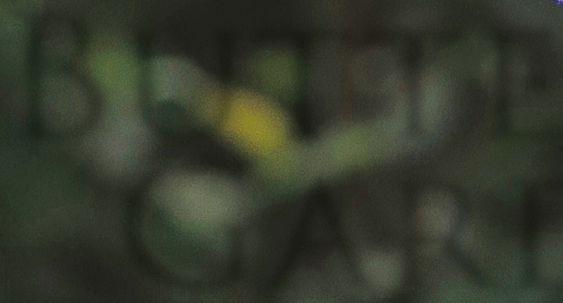









Volume 24, Issue 4
Winter 2019
“Planting” the Love of Butterfies
Caterpillar Hunting: An Interview with David Moskowitz
Wanted Alive in Your Garden: Cloudless Sulphur Caterpillar










During the past year, Volume 24 of Butterfy Gardener has featured a number of new writers as well as many familiar ones. Thanks to Allison Snopek Barta, Mary Benton, Jan Dixon, Ellen Federico, Anne Francois, Jeffrey, Judah, Mason, and Remy Glusman, Berlinda Good, Jill Gorman, Lenora Larson,Gary Noel Ross, Al Schirmacher, Elizabeth Stoakes, Maribell Trujillo-Fruitstone, and Peter Waldeck for sharing their talented writing and exceptional photos
Each issue of this magazine is improved by the help of Associate Editor Mary Anne Borge who continues to help steer this ship with her writing, photographs, insightful editing, and enthusiasm. Sharon Wander’s copy editing of each issue also contributes to the clarity and accuracy of the magazine.
As always, great thanks is given to the NABA Board of Directors for their continued efforts of preserving and promoting butterfy habitats and gardens in North America.
—Jane Hurwitz, Editor
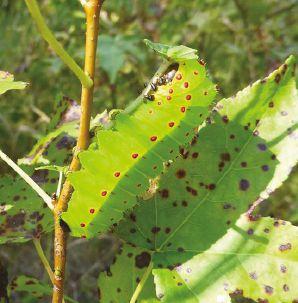
Luna moth caterpillar, photo above, and the same caterpillar photographed under ultraviolet light, photo right. Photos by David Moskowitz
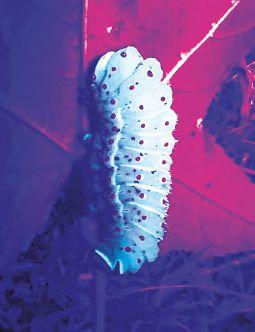
Butterfy Gardener is published quarterly by the North American Butterfy Association, Inc. (NABA). © 2019 by the North American Butterfy Association, Inc. All rights reserved. Views of contributors do not necessarily refect the views of NABA.
Editor: Jane Hurwitz Associate Editor: Mary Anne Borge
We want to hear from you! Please send Butterfy Gardener correspondence and submissions to: Jane Hurwitz, Editor, NABA, 4 Delaware Road, Morristown, NJ 07960; hurwitz@naba.org
Articles, gardening tips and observations, artwork, digital high resolution photographs, poetry and comments will be considered for publication. Please send self-addressed stamped envelope for items to be returned.
Butterfy Gardener welcomes advertising. Please write us at: Butterfy Gardener, 4 Delaware Road, Morristown, NJ 07960, or telephone (973) 285-0907 or fax (973) 285-0936 for current rates and closing dates.
For questions concerning membership issues, magazines, or changes of address, please write to NABA Membership Services, 4 Delaware Road, Morristown, NJ 07960. Occasionally, members send membership dues in twice. Our policy in such cases, unless instructed otherwise, is to extend membership for an additional year.
















Dear Editor,








hen read the article about Pipevine Swallowtails on page of Volume , ssue 3, all , was disappointed to see that California was not mentioned as a location for these beautiful butter ies, but perhaps they are not widespread in my state.
About four years ago, when learned about and visited Hallberg Butter y Gardens in Sebastopol, California , saw Pipevine Swallowtails ourishing in that beautiful place, and decided to try to establish them in adjacent Mendicino County. purchased two California Dutchman s Pipe vines for my garden to provide habitat, and have encouraged fellow garden club members to join me in this endeavor.
ours truly, lorence E. Callander
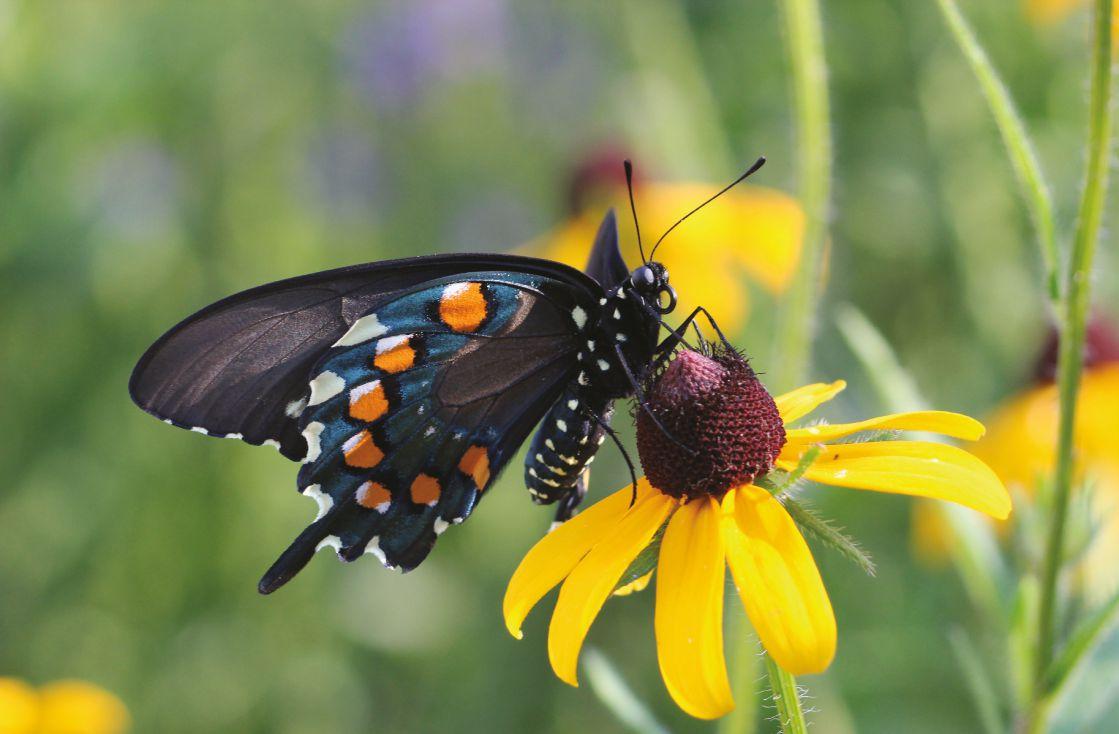

Jill explains the relationship between butter ies and native plants to workshop participants.
have always enjoyed gardening, but it wasn t until found a Gulf ritillary caterpillar years ago that began to garden for butterflies. After researching plants that would benefit the butterflies in my area, designed a garden, starting many native caterpillar food plants from seeds and cuttings rather than buying them. My plant propagation endeavor was wildly successful, producing plenty of extra plants. After giving many away to excited gardeners, realized that many people want to garden for butterflies but don t know where to begin, so created a workshop to combine with my plant giveaway event.
Every year collect about , seeds, root cuttings, and stem cuttings from my garden. n January, seeds are started under grow lights in my house, then as the weather warms up in March, all of the seedlings are transplanted from germination trays to individual pots. For each plant species create a handout that includes photos, growing re uirements, and host-plant information. During the workshop a detailed sign that includes the handout info is displayed next to each plant.
Jill s Butterfly Garden orkshop and Native Plant Giveaway, held each April, is an event that has grown steadily, with about participants in . The workshop begins with a 3 -minute tour of my garden, where describe the purpose of each plant, explain about how host plants are


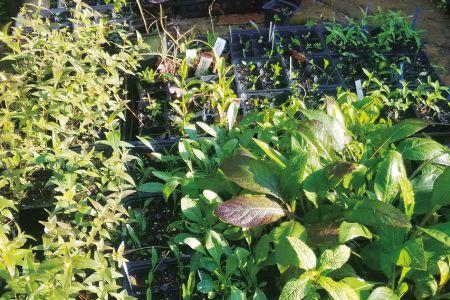
Many plants for the Jill’s Native Plant
Giveaway are started from seed. op: seedlings in anuary Middle: Seedlings in e ruary Bottom: Seedlings in April.
needed for caterpillars, and emphasize how to choose nectar plants that bloom at different times so that adult butterflies can find food throughout the season. also show off some eggs and caterpillars that have found a home in my garden. sually the timing also works out for the release of a few Monarch raised from eggs found in my garden a month earlier. Adults and children alike enjoy seeing all stages of the life cycle of butterflies.
After answering any uestions, invite everyone to choose some plants from the or so species typically have available. This event allows people to try adding some native plants to their gardens for little or no cost—an opportunity for them to see how natives are not only low maintenance but also beautiful and ecologically important. My workshop is also an opportunity to raise money for NABA, so re uest a completely voluntary donation of per plant. Some of my visitors take home just a few plants for pots on their patio, while more-ambitious gardeners may take more than a hundred plants to embellish their large landscapes. My two sons, ages and , help me with the whole process, from planting seeds and transplanting seedlings, to assisting during the workshop by handing out information and helping people find plants.
Through my workshop also share information about my other program, called Caterpillars in the Classroom. provide teachers with caterpillars and chrysalises that are locally raised right in my garden so that they don t need to order mass-produced livestock. or those who want caterpillars, can also supply enough host-plant material so that students can see how caterpillars naturally eat real leaves, rather than smashed food at the bottom of a cup. f teachers don t have time for caterpillars, provide them with chrysalises so that children can experience the joy of watching a butterfly eclose. hen my schedule allows, also enjoy visiting classrooms to teach about butterflies. My program can reach teachers only in my area, but would love for others to join me in sharing our love of butterflies with kids. Please check out www.facebook.com caterpillarsintheclassroom for more information.
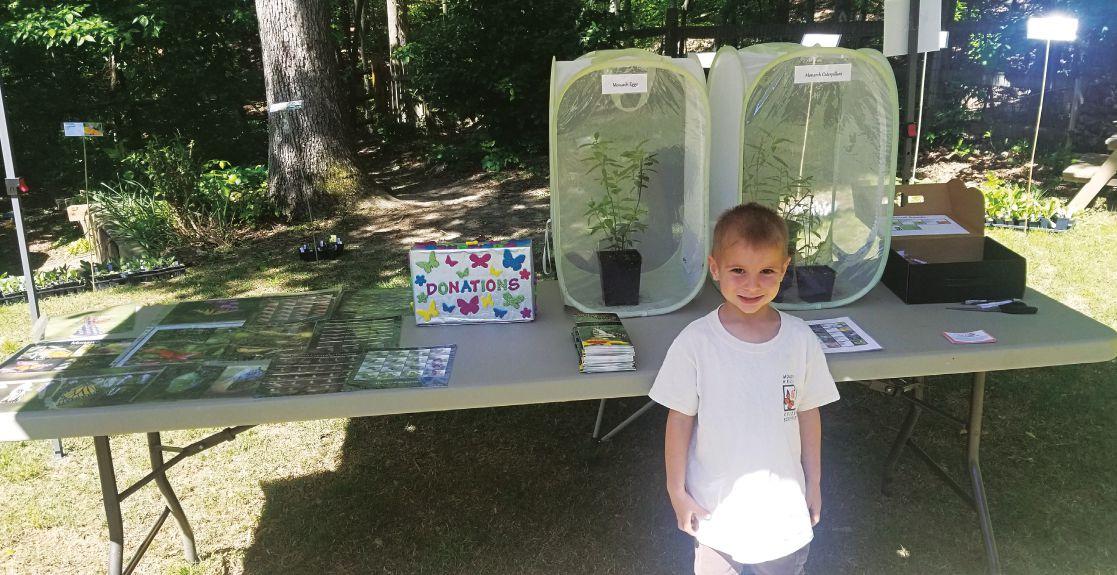
love being able to share my plants and knowledge with others. Having held this event for the past three years, will be taking next year off while my family moves. have made the most of my half-acre suburban property, but am now looking forward to expanding to a few acres outside of Gainesville, GA. This added space will allow my event to be even bigger and better in To explore how organize the workshop, you can visit the event page at www.facebook.com events 3 f you are interested in attending the workshop, please visit the website for more information.
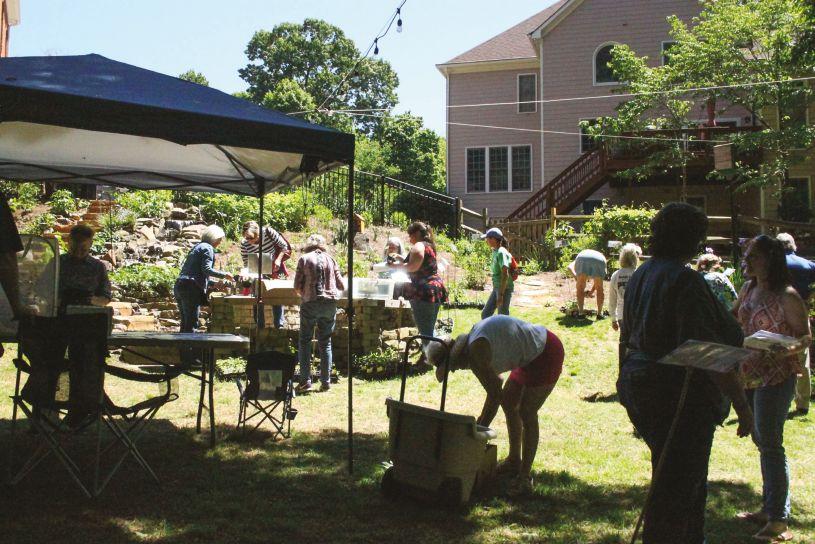
orkshop participants choose plants and pick up informational handouts.
Jill Gorman is a cardiac anesthetist and mother of two boys who enjoys gardening with native plants, photography and hiking. She loves sharing her knowledge and passion for utterfies ith anyone who wants to learn.
by Jane Hurwitz
Photos by David Moskowitz
Why did you begin using ultraviolet light at night to hunt for caterpillars?
A few years ago I started seeing postings on Facebook about using UV fashlights to hunt caterpillars at night. It looked so cool to me that I ordered a UV fashlight immediately and spent the rest of that fall looking at all the creatures that fuoresce at night. Over the winter I considered what applications the UV fashlight would have other than the fun of fnding caterpillars that are notoriously diffcult to fnd during the day.
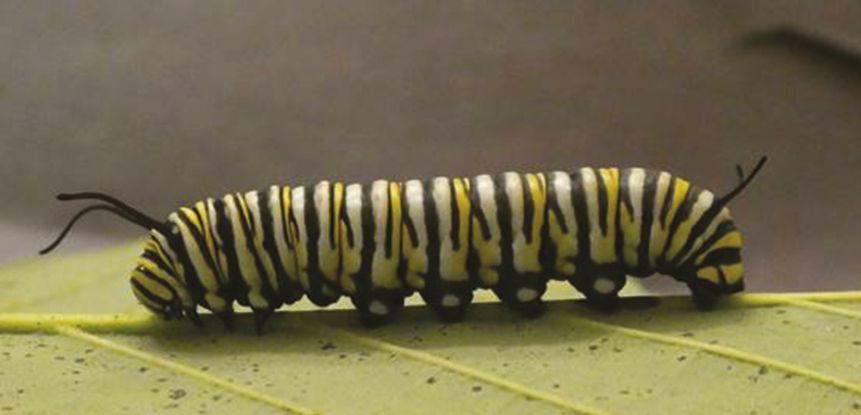

Bottom: The same caterpillar photographed using ultraviolet light.
The following spring I headed to Cape May Courthouse in South Jersey in search of Frosted Elfns, a springfying hairstreak that is classifed as a Threatened species in New Jersey. While there, I saw a lot of fying adults, which was my goal, but on a second trip a few weeks later I did not, so I started looking for their caterpillars on Wild Indigo in the same area. An hour of intensive searching produced a few Frosted Elfn caterpillars. That evening I returned with a UV fashlight and found many caterpillars, both early and late instars–the UV light made the caterpillars easy to spot.
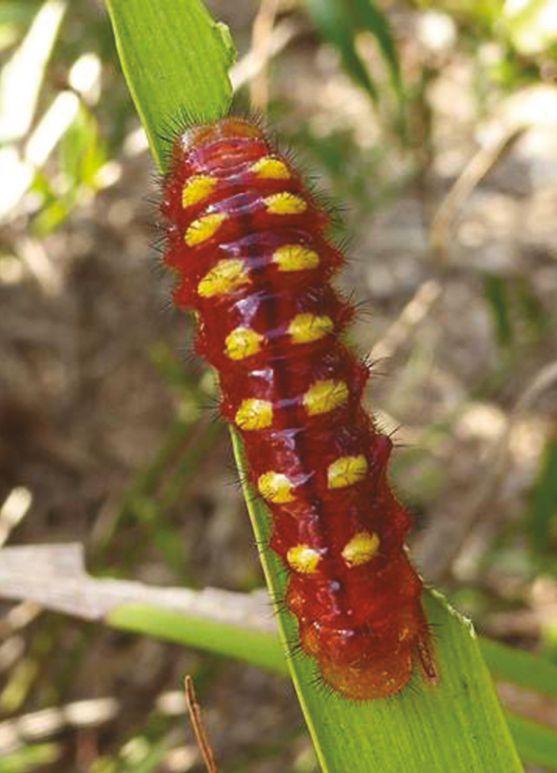

I started a formal survey—checking a number of different sites over different periods—that resulted in a paper on the use of ultraviolet light for surveying Frosted Elfn caterpillars that has been accepted by Journal of Insect Conservation.
So your experience using UV light at night went from an interesting pastime to research…
Yes, using the UV fashlight to survey for caterpillars is a fantastic tool because it allows us to observe caterpillars without disturbing the vegetation. Additionally, it will allow us to fnd early- instar caterpillars, which are normally diffcult to fnd. But it is also fun to be able to go out and see things that you would never notice otherwise. Looking at host plants to fnd caterpillars can tell us a lot about the ecology of a location and about host plant selection.
What suggestions do you have for people who want to survey caterpillars at night? What type of fashlight is needed and can you share some hints on how a novice nighttime caterpillar hunter might achieve success?
Two general types of UV fashlights are commonly sold––the frst type has 51 UV LED lights and the other has 100 UV LED lights. I have found that the fashlights with 51 LED lights are just not bright enough, so I suggest using a fashlight with 100 UV LEDs.
Although rechargeable UV LED fashlights are on the horizon, most available fashlights use AA batteries. As the fashlights are used, the intensity of light decreases before the batteries are exhausted. Even after one hour of use, the intensity of the projected light decreases noticeably, so consider changing batteries frequently for optimum viewing.

A Spicebush Swallowtail caterpillar photographed in natural light.
Since many of the species that we see fying during the day are not breeding in our yards, your nighttime surveys will be much more successful if you search at night in a park or more natural area—a power line cut, for example—where biodiversity is greater.
UV-blocking safety glasses are a necessity when using UV LED fashlights, since ultraviolet light can cause eye irritation or damage. Never look into the lights on your fashlight!
I always carry a regular fashlight in addition to the UV fashlight. Often the UV fashlight will show just a small spot of glowing light because the caterpillar is mostly obscured by leaves. Having a regular fashlight allows me to use the small dot of UV light as a guide to search behind leaves and fnd the caterpillar.
I also aways carry a large stick with a hook on the end. During the day I would never notice a caterpillar among tree leaves a few feet above my head, but the UV light allows me to spot them, and with the stick I can pull the branch down for closer examination.
Timing is also important. Along the East Coast I think late June and July are the optimal times to see the widest variety of caterpillars (which includes both moth and butterfy caterpillars). September to October is also good, because many caterpillars, particularly those of silk, slug, and sphinx moths, are getting ready to overwinter and are in their later instars, so they are large, plump, and easy to fnd.
A Spicebush Swallowtail caterpillar photographed using ultraviolet light.
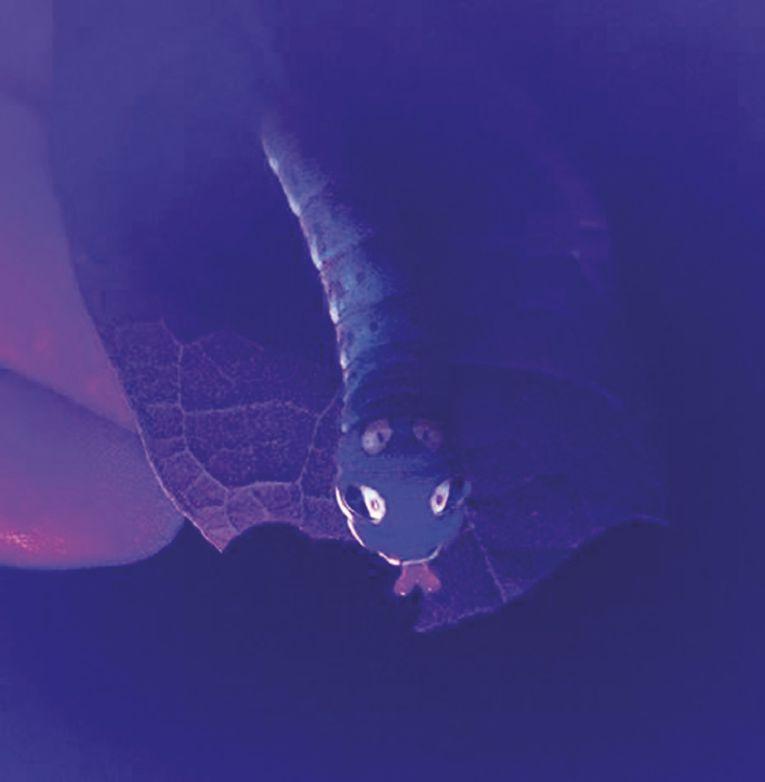
Does it take hours to fnd just a few caterpillars? How long do you stay out at night?
If in the yard, I stay out until my wife calls me in! But actually, the answer is “it depends,” because the more you look, the more you fnd. I would encourage everyone to be out as much as they can because observations will vary from night to night. Much like looking for butterfies during the day, each person develops a search image for themselves of what a particular butterfy or caterpillar looks like, which makes subsequent searches easier. The same is true for observations with UV fashlights it takes a bit of time to learn what a caterpillar looks like under those conditions. As we become familiar over time with the patterns and images that caterpillars make under UV light, it becomes easier to spot them.
For all caterpillar hunting, both day and night, it is easier to fnd caterpillars along edges where two habitats are transitioning, say from forest to feld. This is particularly true for moth caterpillars but certainly holds for at least some of the butterfy caterpillars as well. Some caterpillars only live in the tops of trees so you will never see them, but UV light helps you fnd those that are easily accessible.
David Moskowitz holds a Ph.D. in Entomology from Rutgers University. He is a Senior VicePresident with EcolSciences, Inc. in Rockaway, New Jersey. Dr. Moskowitz is also the co-founder of National Moth Week (nationalmothweek.org), an international event held each year in the last week in July. He also created the Facebook page BugAddiction – Confessions of a Bug Addict (https://www.facebook.com/BugAddictionConfessionsOfABugAddict/) and has published numerous papers on insects and other wildlife in peer-reviewed journals and popular nature-based publications.
















Please photocopy this membership application form and pass it along to friends and acquaintances who might be interested in NABA. www.naba.org
Yes! I want to join NABA and receive American Butterflies and Butterfly Gardener and/or contribute to the creation of the premier butterfly garden in the world, NABA’s National Butterfly Center. The Center, located on approximately 100 acres of land fronting the Rio Grande in Mission, Texas, uses native trees, shrubs and wildflowers to create a spectacular natural butterfly garden that significantly benefits butterflies, an endangered ecosystem, and the people of the Rio Grande Valley.
Name:
Address:
Email:
Telephone:
Special Interests (circle): Listing, Gardening, Observation, Photography, Conservation, Other:
For a $35 donation, one receives NABA publications as either digital or print. All higher levels of donations receive both digital and print versions. Outside the U.S., only digital is available, at any donation level.
Tax-deductible dues (donation) enclosed (circle): Regular $35 (must choose either digital or print — circle one), Family $45. Special sponsorship levels: Copper $55; Skipper $100; Admiral $250; Monarch $1000. Institution/Library subscription to all annual publications $60. Special tax-deductible contributions to NABA (please circle): $125, $200, $1000, $5000. Mail checks (in U.S. dollars) to NABA, 4 Delaware Rd., Morristown, NJ 07960.
Articles, gardening tips and observations, artwork, digital high resolution photographs, poetry and comments will be considered for publication. Contact Jane Hurwitz, Editor, hurwitz@naba.org
Advertising
Butterfly gardener welcomes advertising. Please contact us for current rates and closing dates at naba@naba.org, or telephone 973.285.0907, or fax 973.285.0936
Membership Services
If you have questions about duplicate magazines, missing magazines, membership expiration date, change of address, etc., please write to NABA Membership Services, 4 Delaware Rd., Morristown, NJ 07960. Occasionally, members send membership dues twice. Our policy in such cases, unless instructed differently, is to extend membership for an additional year. NABA sometimes exchanges or sells its membership list to like-minded organizations that supply services or products that might be of interest to members. If you would like your name deleted from membership lists we supply to others, please write and inform us at: NABA Membership Services, 4 Delaware Rd., Morristown, NJ 07960.

Known Food Preferences: Cloudless Sulphur caterpillars eat the foliage, fowers, and seedpods of a variety of plants in the Pea Family, such as American Senna, Maryland Senna, Partridge Pea, Sensitive Partridge Pea, Java-bean, and Woolly Senna.

Known disguises: Cloudless Sulphur caterpillars rely on blending in with their surroundings for protection. In general, caterpillars that feed primarily on the yellow fowers of their food plant are yellow colored, while caterpillars that eat foliage are green. Both the yellow and green forms of the Cloudless Sulphur caterpillar have spots, lines, and dots on their bodies that help provide further camoufage among the leaves and fowers of their host plant.
Hideouts: In addition to their disguises, Cloudless Sulphurs can spin silk to make a shelter from one or more leaves.
If capture is avoided: After the caterpillar forms its striking, humpbacked chrysalis, metamorphosis continues, with multiple broods in the southern part of its range, fewer in the north. Cloudless Sulphurs can be found in gardens and disturbed open spaces in all of the southern United States. Additionally, some Cloudless Sulphurs fy north each fall— an activity that over time may result in a range expansion for the species.
Currently, however, these butterfies are not thought to be able to survive the winter farther north than the Carolinas. In order to avoid freezing temperatures, millions of Clouded Sulphurs fy southward each fall to frost-free areas where they overwinter as adults in reproductive diapause.
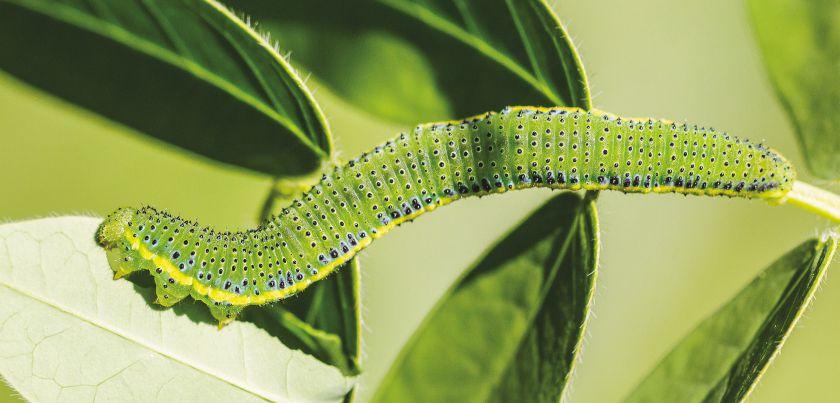

Mary Anne Borge is an Associate Editor of Butterfly Gardener, an instructor at Bowman’s Hill Wildflower Preserve, and a Pennsylvania Master Naturalist. She enjoys sharing her love of nature through her writing and photography at her blog, www.the-natural-web.org.

The Regal Fritillary hatches late in the year. Its food is scarce, but it says, “Never Fear!”
I’ll sleep through the winter, Before I eat dinner.
I’ll feast in spring when the violets appear.
---Elizabeth Stoakes